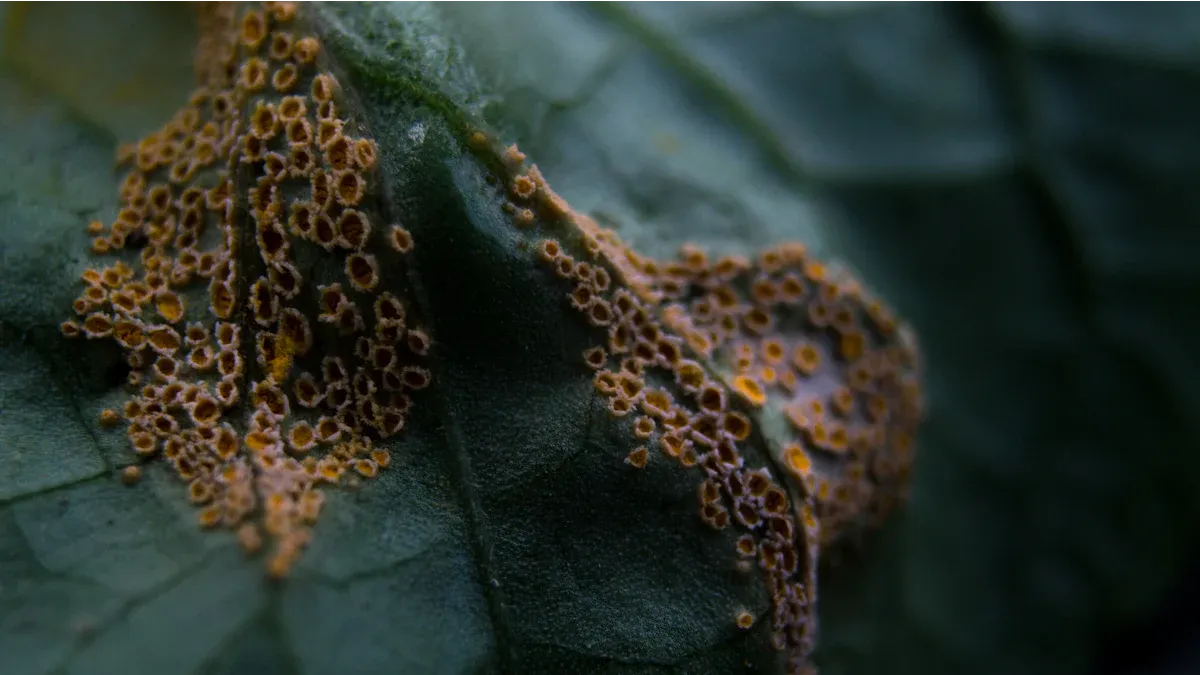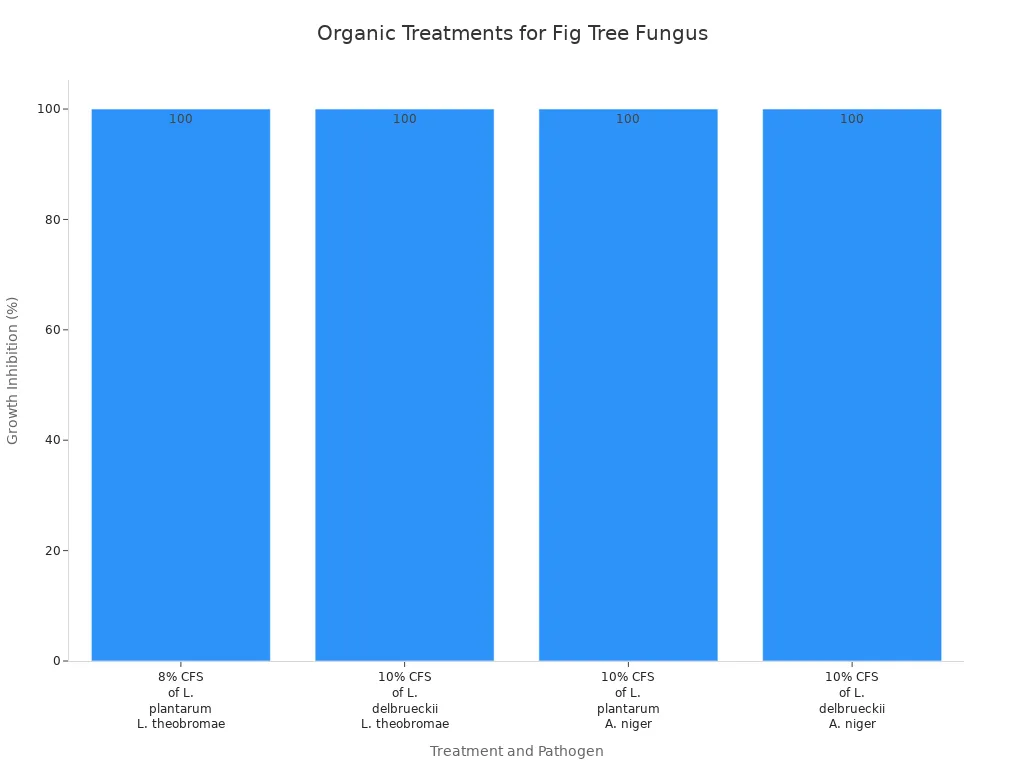
Addressing fungus on your fig tree plants is crucial for their health. Fungal infections can weaken your trees, leading to poor growth and reduced fruit production. Many gardeners worry about these issues, seeking effective solutions to protect their plants. Understanding how to get rid of fungus will help you maintain a thriving fig tree and ensure its longevity.
Key Takeaways
Identify common fungal diseases like powdery mildew, root rot, and leaf spot to manage them effectively.
Use organic solutions like neem oil and baking soda to treat fungal infections safely and effectively.
Maintain proper watering techniques to prevent overwatering and ensure good drainage for healthy roots.
Regularly inspect your fig trees for symptoms like discoloration and wilting to catch problems early.
Keep the area around your fig trees clean by removing fallen leaves and debris to reduce fungal risks.
Common Types of Fungus

Fungal diseases can significantly impact the health of your fig trees. Understanding the common types of fungus helps you identify and manage these issues effectively.
Powdery Mildew
Powdery mildew is a prevalent fungal disease that appears as a white, powdery coating on leaves, stems, and fruits. This fungus thrives in warm, dry conditions with high humidity. You may notice stunted growth and reduced fruit quality as the disease progresses. To combat powdery mildew, ensure proper air circulation around your fig trees and consider applying organic fungicides.
Root Rot
Root rot is another serious issue caused by pathogens like Phytophthora or Fusarium. Symptoms include wilting leaves, stunted growth, and blackened or mushy roots. This disease often results from waterlogged soils and poor drainage. To prevent root rot, maintain well-draining soil and avoid overwatering your fig trees.
Leaf Spot
Leaf spot manifests as dark, water-soaked areas on leaves, which can lead to premature leaf drop. This fungal disease can weaken your fig trees and reduce their overall vigor. Regularly inspect your plants for signs of leaf spot and remove any affected leaves to minimize the spread of the fungus.
Here’s a summary of some common fig tree diseases and their management strategies:
Disease Name | Fungi Species | Symptoms | Management Strategies |
|---|---|---|---|
Alternaria rot | Alternaria spp., Cladosporium herbarum, Ulocladium altum | Olive-green specks or sunken lesions on fruit; water-soaked areas. | Pick fruit before overripe; reduce dust in orchards. |
Aspergillus rot | Aspergillus spp. | Bright yellow internal tissue; powdery mass of spores. | Provide adequate irrigation; reduce dust in the orchard. |
Botrytis limb blight | Botrytis cinerea | Cankers on limbs; wilting foliage; buff colored spores. | Prune infected areas just below the canker. |
Fig Rust | Physopella fici | Yellow-green flecks on leaves; defoliation. | Start fungicide applications in early spring; avoid spraying when fruit is small. |
By recognizing these common fig issues, you can take proactive steps to protect your fig trees from fungal diseases.
Symptoms of Fungal Problems

Identifying the symptoms of fungal problems early can save your fig trees from severe damage. Here are some common signs to watch for:
Discoloration of Leaves
One of the first signs of a fungal problem is the discoloration of leaves. You may notice yellowing or browning patches on the foliage. This change often indicates that your fig tree is struggling with a fungal infection. Pay close attention to any unusual color changes, as they can signal the need for immediate action.
Wilting and Dropping Leaves
Wilting and dropping leaves are also clear indicators of fungal issues. If your fig tree’s leaves appear limp or start to fall off prematurely, it may be suffering from root rot or another fungal disease. This symptom often occurs when the roots cannot absorb water properly due to fungal damage. Regularly check your plants for wilting leaves, as this can help you catch problems early.
Unusual Growths
Unusual growths on your fig tree can indicate a fungal problem as well. You might see abnormal bumps, mold, or even a powdery substance on the leaves and stems. These growths can hinder the tree’s ability to photosynthesize and absorb nutrients. If you spot any strange formations, take action quickly to prevent further spread.
By recognizing these symptoms, you can act promptly to address any fungal problems affecting your fig trees. Early detection is key to maintaining the health and productivity of your plants.
Get Rid of Fungus: Treatment Options
When you notice fungus on your fig tree plants, taking action quickly is essential. Here are some effective treatment options to help you get rid of fungus and restore your plants’ health.
Organic Solutions
Using organic solutions can be a safe and effective way to treat fungal infections. Here are two popular methods:
Neem Oil: Mix two tablespoons of neem oil with a gallon of water and a few drops of dish soap. Spray this mixture on the affected leaves. Neem oil works by disrupting the life cycle of the fungus, making it harder for it to thrive.
Baking Soda Solution: Combine one tablespoon of baking soda, one tablespoon of vegetable oil, and a gallon of water. Spray this solution on your fig tree every two weeks for best results. This method helps to create an alkaline environment that is unfavorable for fungal growth.
These organic treatments have shown effectiveness against various fungal pathogens. In fact, studies indicate that organic treatments can achieve up to 100% growth inhibition against certain fig tree pathogens, as shown in the table below:
Treatment | Pathogen | Growth Inhibition |
|---|---|---|
8% CFS of L. plantarum | L. theobromae | 100% |
10% CFS of L. delbrueckii | L. theobromae | 100% |
10% CFS of L. plantarum | A. niger | 100% |
10% CFS of L. delbrueckii | A. niger | 100% |

Chemical Treatments
For severe fungal infections, chemical treatments may be necessary. Here are some recommended options:
Copper-based or Sulfur-based Fungicides: These fungicides are effective against various fungal diseases. Apply them at the first sign of disease to prevent further damage.
Fungicides for Fig Rust: Use fungicides containing lime and copper sulfate. Spray the tree and surrounding soil every two or three weeks during its dormant season for the best results.
While chemical treatments can be effective, they come with potential risks. You might notice spots or blotches on leaves, deformed leaves, or sudden leaf shedding after application. Chemical exposure can injure plants under certain conditions, even when applied as directed. Always follow the instructions carefully to minimize risks.
Repotting and Cleaning Roots
If your fig tree suffers from root rot, repotting may be necessary. Here’s how to do it safely:
Remove the Plant: Gently take the fig tree out of its pot. Be careful not to damage the roots.
Inspect the Roots: Look for blackened or mushy roots. Trim away any affected areas with sterilized scissors.
Clean the Pot: Disinfect the pot with a bleach solution to kill any lingering pathogens.
Repot: Use fresh, well-draining soil to repot your fig tree. This helps to prevent future fungal issues.
Additionally, always clean your tools after working with infected plants to avoid spreading diseases. Follow these steps to ensure your fig tree receives the best care possible.
By implementing these treatment options, you can effectively get rid of fungus and promote the health of your fig trees.
Preventing Fungal Problems
Preventing fungal problems is essential for maintaining the health of your fig trees. By implementing effective strategies, you can significantly reduce the risk of fungal infections and promote robust growth.
Proper Watering Techniques
Proper watering techniques play a vital role in preventing fungal infections in fig trees. You should aim to maintain a consistent watering schedule that meets the seasonal needs of your plants. Overly wet conditions can lead to fungal growth, so it’s crucial to avoid waterlogging the soil. Water your fig trees deeply but infrequently, allowing the top inch of soil to dry out between waterings. This approach helps keep the roots healthy and reduces the risk of root rot.
Cleaning Leaf Litter
Cleaning leaf litter around your fig trees is another effective prevention strategy. Fallen leaves can harbor fungal spores, which may infect your plants. Regularly raking up and disposing of any dead leaves or debris helps minimize the chances of fungal growth. This simple task not only keeps your garden tidy but also protects your fig trees from potential diseases.
Improving Air Circulation
Improving air circulation around your fig trees is crucial for preventing fungal growth. Here are some tips to enhance airflow:
Space fig trees at least ten feet apart to enhance air movement.
Prune in late winter to allow better air circulation through the canopy.
Avoid overhead watering, especially in the late afternoon and evening, to reduce leaf wetness.
Rake up and remove fallen, diseased leaves to prevent fungal growth.
By following these practices, you create an environment that is less conducive to fungal infections. Remember, warm and humid conditions favor fungal growth, so managing moisture and airflow is key.
Implementing these preventive measures not only protects your fig trees from fungal problems but also promotes their overall health. Long-term benefits include better pest control, disease prevention, and improved care techniques. Regular watering, fertilizing with compost, and careful pruning will help your fig trees thrive.
By taking these steps, you can enjoy healthy, productive fig trees for years to come.
In summary, addressing fungus on your fig trees is vital for their health and productivity. Here are some key takeaways to remember:
Prune and remove infected parts promptly to prevent the spread of spores.
Avoid water stagnation and ensure good air circulation to reduce humidity that promotes fungal growth.
Use specific antifungals early in the season or at the first signs of infection.
Improve soil drainage and consider transplanting if root rot persists.
Regular monitoring and maintenance can significantly enhance the overall health of your plants. Inspect your fig trees often for early signs of disease. Keep the area clean by removing fallen leaves and fruit. Prune to improve air circulation and water at the base to prevent wet foliage. By following these practices, you can enjoy healthy and thriving fig trees for years to come.
FAQ
What causes fungus on fig trees?
Fungus on fig trees often results from excessive moisture, poor air circulation, or infected soil. Overwatering and high humidity create ideal conditions for fungal growth.
How can I tell if my fig tree has a fungal infection?
Look for signs like discoloration of leaves, wilting, or unusual growths. These symptoms indicate that your fig tree may have a fungal infection.
Can I use home remedies to treat fungus on fig trees?
Yes, home remedies like neem oil and baking soda solutions can effectively treat fungal infections. Apply these treatments regularly for the best results.
How often should I check my fig trees for fungal issues?
Inspect your fig trees at least once a week. Early detection of fungal problems allows you to take action quickly and protect your plants.
What should I do if my fig tree has root rot?
If your fig tree has root rot, repot it in fresh, well-draining soil. Trim any damaged roots and ensure proper watering practices to prevent future issues.

